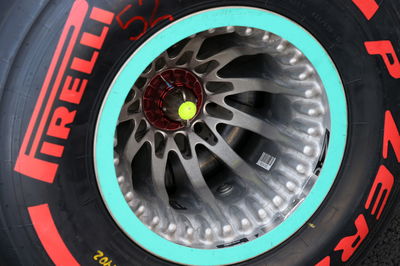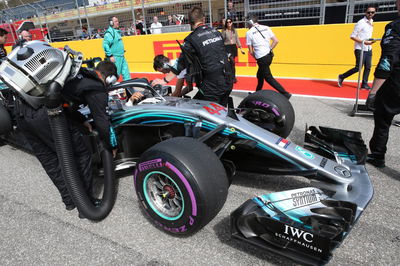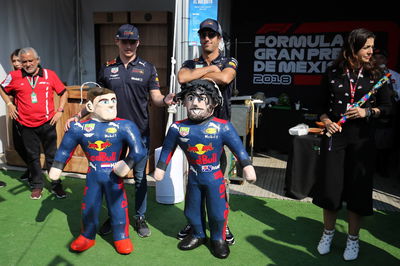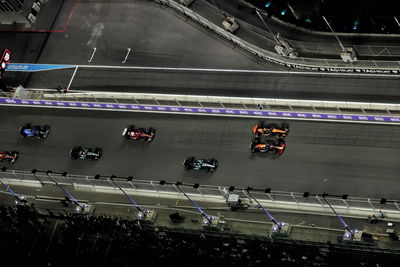Mercedes cleared by FIA to use new rear wheel design
Mercedes has been cleared by the FIA stewards to use a new rear wheel design featuring holes in the rim following a request for clarification from the Formula 1 team.
Mercedes was first spotted to be using the new rear wheel design early in the United States Grand Prix weekend in Austin, only for the team to then return to its regular design where the holes are covered up for fear of a possible protest from a rival team.

Mercedes has been cleared by the FIA stewards to use a new rear wheel design featuring holes in the rim following a request for clarification from the Formula 1 team.
Mercedes was first spotted to be using the new rear wheel design early in the United States Grand Prix weekend in Austin, only for the team to then return to its regular design where the holes are covered up for fear of a possible protest from a rival team.
In a bulletin issued by the FIA race stewards in Mexico on Thursday ahead of this weekend's on-track action, it was confirmed that Mercedes had requested further clarification after receiving an advisory from the FIA technical department earlier this month.
"Art 12.8.1 of the Technical Regulations permits 'spacers on the inboard mounting face of identical specification on all wheels for the same axle.' Mercedes runs such a spacer on their rear wheels and in order to reduce the heat flow across the junction between the axle and the wheel, they have added a number of small holes and grooves for cooling," the FIA report reads.
"Following the 2018 race in Japan, understanding that this scheme was in question, Mercedes requested clarification from the FIA’s Technical Department, as to whether this arrangement violated Art 3.8 of the Technical Regulations, which says in part 'any specific part of the car influencing its aerodynamic performance must remain immobile in relation to the sprung part of the car.' The question therefore, was whether the air passing through these holes and grooves violated this provision.
"The FIA’s Technical Department provided advice to the team, which in part confirmed that in the opinion of the Technical Department, that the configuration of the part in question would be in compliance with the Technical Regulations."
The stewards explained that while their jurisdiction "extends solely to this event" in Mexico, thus preventing them from making a more generalised interpretation of the technical ruling, they agreed that "the opinion of the FIA technical department is correct" when it said the rim would comply with the regulations.
"Therefore, the Stewards confirm that should Mercedes run the part as described in the correspondence between Mercedes and the FIA’s Technical Department, the Stewards would consider this part to be in conformity with the regulations, but only with respect to the points raised in Mercedes request," the statement concludes.

THE STEWARDS' REPORT IN FULL
The Stewards received a written request by Mercedes Benz Grand Prix, Ltd, operating as Mercedes-AMG Petronas Motorsports (“Mercedes”) to settle a matter, as is provided for in the International Sporting Code’s Art 11.9 “Authority of the Stewards”, specifically Art 11.9.2.b which states that “They may settle any matter which may arise during an Event, subject to the right of appeal provided for in the Code.”
Art 12.8.1 of the Technical Regulations permits “spacers on the inboard mounting face of identical specification on all wheels for the same axle.” Mercedes runs such a spacer on their rear wheels and in order to reduce the heat flow across the junction between the axle and the wheel, they have added a number of small holes and grooves for cooling. Following the 2018 race in Japan, understanding that this scheme was in question, Mercedes requested clarification from the FIA’s Technical Department, as to whether this arrangement violated Art 3.8 of the Technical Regulations, which says in part “any specific part of the car influencing its aerodynamic performance must remain immobile in relation to the sprung part of the car.” The question therefore, was whether the air passing through these holes and grooves violated this provision.
The FIA’s Technical Department provided advice to the team, which in part confirmed that in the opinion of the Technical Department, that the configuration of the part in question would be in compliance with the Technical Regulations.
As with all advice given to the teams by the FIA’s Technical Department, the teams are reminded in those documents that they are “Advisory in nature and do not constitute Technical Regulations. it is for the Stewards, and ultimately the FIA International Court of Appeal, to offer binding interpretations of the Technical Regulations.“
Thus Mercedes requests: “A) Confirmation from the Stewards of the interpretation of Article 3.8 of the Regulations as set out in the FIA’s Clarification and so the legality of the Part; or “B) details of all changes required to the Clarification such that certainty surrounding the correct interpretation of Article 3.8 is achieved.”
The Stewards find that:
1. Our jurisdiction extends solely to this Event, and therefore decline to make a generalized interpretation of Art. 3.8. Further, we agree with the FIA Technical Department’s position that this would have to be addressed on a case by case basis, taking into account, at least, the specific points in the FIA Technical Department’s document of the 16th of October, 2018.
2. The FIA’s Clarification and acceptance of the part specifically states that it is limited to the part presented by Mercedes in their submission to the FIA and that alternative design options would have to be considered separately.
3. The opinion of the FIA Technical Department is correct when they state:
“Regarding the legality of the holes in the spacer: “1. To determine whether the holes have an aerodynamic influence, one has to consider their size, shape and function. Small holes will tend to have primarily a cooling function, and while we can at times consider cooling to be an aspect of aerodynamic performance, we feel that cooling of very localized areas (as in your design) can be acceptable. “2. The spacer is specifically part of the wheel assembly (as mentioned in Article 12.8.1), so provided its main function is that of a spacer, we feel that having some localized bleeding of the flow for cooling can be acceptable. The fact the spacer rotates is inherent in its function, in much the same way that the wheel rim spokes rotate. Hence for the above reasons, we consider the spacer geometry you have adopted to be permissible, although we would reserve [the] right to judge alternative geometries, and to change this view if (for example) the spacer were to grow beyond its primary function (that of a spacer) and if the holes were to become big enough to have a more significant aerodynamic effect.”
Therefore, the Stewards confirm that should Mercedes run the part as described in the correspondence between Mercedes and the FIA’s Technical Department, the Stewards would consider this part to be in conformity with the regulations, but only with respect to the points raised in Mercedes request.
Competitors are reminded that they have the right to appeal the decisions of the Stewards (with the exception of those referred to in Article 12.2.4 of the FIA International Sporting Code), in accordance with Article 15 of the FIA International Sporting Code and Article 9.1.1 of the FIA Judicial and Disciplinary Rules, within the applicable time limits.











